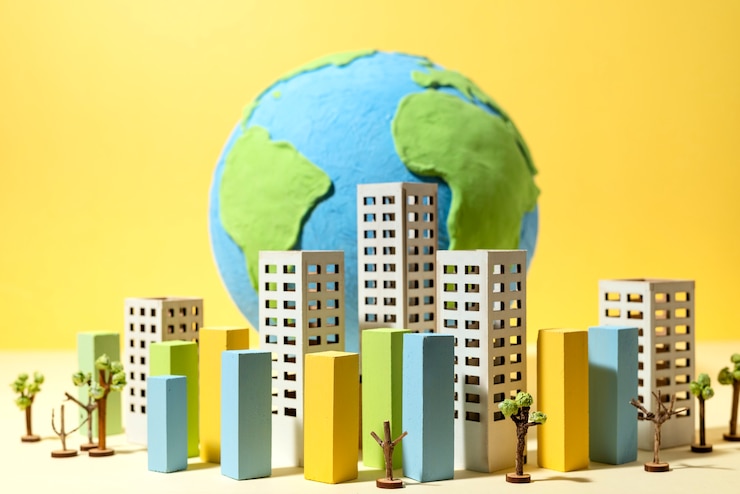
In the dynamic realm of real estate, where every parcel of land tells a story, the narrative is increasingly influenced by a protagonist often overlooked – the environment. This article embarks on a deep dive into the intricate interplay between environmental factors and land value, unraveling the threads of sustainable real estate that weave a tapestry of ecological consciousness and financial prudence.
Ecological Footprint: Unraveling the Threads of Impact
At the very core of sustainable real estate lies an awareness of the ecological footprint each development leaves on the land. This goes beyond mere carbon emissions; it encompasses a holistic understanding of how human activities, infrastructure, and land use impact the delicate balance of ecosystems.
Understanding this footprint is crucial for stakeholders aiming not just at profitability but at responsible stewardship of the land.
Green Infrastructure: Nurturing the Landscape
In the lexicon of sustainable real estate, the term green infrastructure becomes a guiding principle. It transcends the traditional concrete jungle, emphasizing the incorporation of natural elements like parks, green roofs, and permeable surfaces. These features not only enhance the aesthetics of a development but also contribute to biodiversity and ecosystem health.
Developers who prioritize green infrastructure are not only crafting visually appealing landscapes but also investing in the long-term vitality of the land.
Energy Efficiency: Illuminating Sustainable Pathways
In the pursuit of sustainable real estate, the illumination of pathways toward energy efficiency becomes a beacon. This involves deploying technologies and design principles that minimize energy consumption, harness renewable sources, and reduce the overall carbon footprint of a development.
Land value, in the context of sustainable energy practices, becomes not just a monetary metric but a reflection of responsible energy stewardship.
LEED Certification: A Mark of Distinction
For developers committed to the pinnacle of sustainable construction, LEED (Leadership in Energy and Environmental Design) certification becomes a mark of distinction. Awarded based on a project’s adherence to rigorous environmental standards, achieving LEED certification elevates the status of the land from a mere commodity to a symbol of environmental responsibility.
Landowners can witness an enhancement in value as the market increasingly recognizes and values sustainable certifications.
Biodiversity Conservation: Preserving Nature’s Symphony
A harmonious development isn’t just one that aesthetically blends with its surroundings; it actively contributes to biodiversity conservation. Sustainable real estate endeavors to preserve and enhance the biodiversity of the land, recognizing that each species, each tree, is a note in nature’s symphony.
Land value, in this context, reflects not just economic potential but the richness and resilience of the ecosystem it harbors.
Resilient Design: Fortifying Against Environmental Challenges
As the specter of climate change looms, sustainable real estate embraces the concept of resilient design. This involves fortifying developments against environmental challenges such as rising sea levels, extreme weather events, and shifting climate patterns. A resilient property is not only more likely to withstand these challenges but also maintains its value in the face of adversity.
For landowners and developers, resilient design isn’t just a strategic choice; it’s an investment in the longevity of the land.
Carbon Neutrality: Offsetting Environmental Impact
In the pursuit of sustainability, the concept of carbon neutrality emerges as a noble goal. Developers aim to offset the carbon emissions generated during construction and operation, effectively balancing the environmental equation. This not only contributes to a healthier planet but also positions the land as a conscientious investment.
Land value, in the context of carbon neutrality, is intrinsically tied to the development’s commitment to mitigating its environmental impact.
Smart Water Management: Navigating Aquatic Sustainability
Sustainable real estate is not confined to terra firma; it extends to the aquatic realm through smart water management. This involves utilizing technologies to minimize water usage, employing efficient irrigation systems, and implementing strategies to protect water quality. The health of water bodies surrounding a development becomes a reflection of its commitment to holistic sustainability.
Land value, when coupled with responsible water management, becomes a testament to the project’s aquatic stewardship.
Adaptive Reuse: Transforming with Environmental Sensibility
In the pursuit of sustainable real estate, the concept of adaptive reuse emerges as a transformative strategy. Rather than discarding existing structures, developers reimagine and repurpose them. This not only minimizes the environmental impact of new construction but also revitalizes the land with a touch of historical character.
Land value, in the context of adaptive reuse, reflects the ingenuity of repurposing and the preservation of embodied energy within existing structures.
Regenerative Development: Cultivating Positive Impact
Beyond sustainability lies the concept of regenerative development – an approach that seeks not just to minimize harm but to actively contribute to the regeneration of ecosystems. This involves projects that restore habitats, enhance soil health, and foster a net-positive impact on the environment.
Land value, in the realm of regenerative development, becomes a testament to the commitment of stakeholders to leave the land in a better state than they found it.
Conclusion: A Sustainable Legacy in the Soil
As we conclude this deep dive into the impact of environmental factors on land value within the context of sustainable real estate, it becomes evident that land is no longer a passive canvas awaiting development. It is a living entity, deeply intertwined with the ecosystems it hosts and the sustainability choices made upon it.
The value of land, when viewed through the lens of sustainability, transcends the monetary; it becomes a legacy etched into the soil, a testament to the harmonious coexistence of human progress and ecological vitality.
